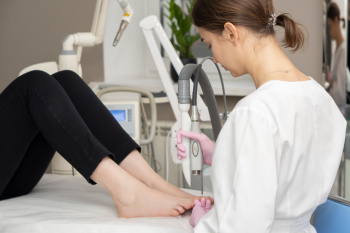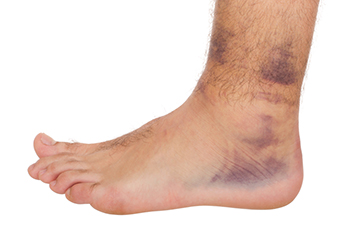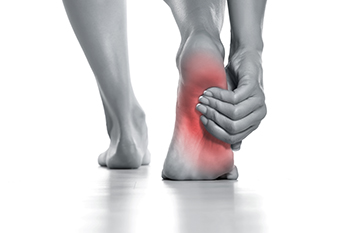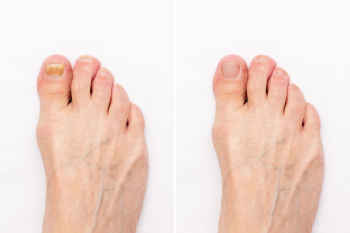Connect With Us
Blog
Items filtered by date: March 2024
The Science Behind Laser Treatment for Fungal Nails

Laser treatment for fungal nails has emerged as a promising solution for individuals seeking effective and non-invasive ways to combat stubborn nail infections. This innovative approach harnesses the power of concentrated light energy to target and destroy fungal organisms residing within the nail bed. During the procedure, the laser emits pulses of high-intensity light, penetrating the nail tissue to eradicate the fungal infection while leaving surrounding tissues unharmed. The laser energy works by heating the fungal cells to a temperature that effectively disrupts their structure and inhibits their ability to thrive and spread. Unlike traditional treatments such as topical antifungal medications or oral drugs, laser therapy offers several advantages, including minimal side effects and no risk of liver toxicity associated with oral medications. While multiple sessions may be required to achieve optimal results, many individuals experience significant improvement in nail appearance and reduction of fungal infection symptoms following laser treatment. If you have toenail fungus, it is suggested that you visit a podiatrist who can determine if laser treatment is right for you.
Laser treatment can be an effective way to get rid of toenail fungus. If you have any questions about laser treatment, consult with Vivian C. Iwu, DPM from Choice Podiatry Center. Our doctor will assess your condition and provide you with quality treatment for fungal nails.
What Are Toenail Fungal Infections?
Onychomycosis, or fungal infection of the nail, is a relatively common and non-serious condition. Around 10 percent of U.S. citizens are afflicted with fungal nails. Common forms of fungus that infect the nail include dermatophytes, yeasts, and molds.
Symptoms of Toenail Fungal Infections Include:
- Nail thickening
- Brittleness of the nail
- Discoloration of the nail
Diagnosis for Fungal Nails
Fungal infections are diagnosed by fungal culture and microscopy. This will rule out any other conditions such as nail trauma, psoriasis, lichen planus, and onychogryphosis.
What Is Laser Treatment?
Laser treatment is a non-invasive, safe, quick, and painless procedure that uses the heat from a laser to kill fungus in the nail. Each infected nail is targeted with a laser for several minutes. The treatment is usually utilized several different times over a select period. During this time, a podiatrist will keep an eye on the infection.
If you have any questions, please feel free to contact our office located in Marietta, GA . We offer the newest diagnostic and treatment technologies for all your foot care needs.
Custom Orthotics For Foot and Heel Pain

Step into relief and reclaim your mobility! Foot and heel pain can be a thing of the past with the right Custom Orthotics. Customized to your unique foot structure, they provide the support and alignment needed to alleviate discomfort. Whether you're walking, running, or simply standing, Custom Orthotics ensure every step is cushioned and pain-free. Don't let foot ailments dictate your day. With Custom Orthotics, embrace a world of comfort and freedom. Call today to schedule an appointment.
Recognizing Symptoms of Ankle Sprains

Ankle sprains occur when the ligaments surrounding the ankle are stretched or torn due to sudden twisting or rolling movements. Recognizing the symptoms of an ankle sprain is essential for prompt and effective treatment. One common symptom is pain, which can range from mild discomfort to severe agony, depending on the extent of the injury. Swelling surrounding the affected area is also a typical sign of an ankle sprain, as the body responds to the trauma by sending fluids to the injured site. Individuals may also experience bruising, tenderness to touch, and difficulty bearing weight on the affected ankle. In some cases, a popping sensation may be felt at the time of injury. It is important to seek medical attention if you suspect an ankle sprain, as proper diagnosis and treatment can prevent further damage and promote faster recovery. If you have any of the above symptoms, you may have sprained your ankle, and it is suggested that you contact a podiatrist for a proper diagnosis and appropriate treatment techniques.
Although ankle sprains are common, they aren’t always minor injuries. If you need your ankle injury looked at, contact Vivian C. Iwu, DPM from Choice Podiatry Center. Our doctor can provide the care you need to keep you pain-free and on your feet.
How Does an Ankle Sprain Occur?
Ankle sprains are the result of a tear in the ligaments within the ankle. These injuries may happen when you make a rapid shifting movement while your foot is planted. A less common way to sprain your ankle is when your ankle rolls inward while your foot turns outward.
What Are the Symptoms?
- Pain at the sight of the tear
- Bruising/Swelling
- Ankle area is tender to touch
- In severe cases, may hear/feel something tear
- Skin discoloration
Preventing a Sprain
- Wearing appropriate shoes for the occasion
- Stretching before exercises and sports
- Knowing your limits
Treatment of a Sprain
In many cases, the RICE method (Rest, Ice, Compression, and Elevate) is used to treat ankle sprains. However, you should see a podiatrist to see which treatment option would work best with your injury. In severe cases, surgery may be required.
It is important to ask your doctor about rehab options after you receive treatment for your injury. Stretching, strength training, and balance exercises may help the ankle heal while also preventing further injury.
If you have any questions, please feel free to contact our office located in Marietta, GA . We offer the newest diagnostic and treatment technologies for all your foot care needs.
Heel Pain Can Be Treated!
Foot Orthotics for Rheumatoid Arthritis Pain

Rheumatic pain and its effect on foot health have been relatively overlooked in the medical community, despite the significant prevalence of foot ailments, particularly as people age. This oversight is surprising considering the potential role of footwear-related issues in modulating rheumatic pain. While much research has focused on structural aspects of arthritis, there has been a lack of emphasis on the foot and non-surgical interventions for addressing lower extremity joint problems in rheumatic diseases. Emerging studies are shedding light on the potential benefits of foot orthotics and specialized footwear in managing conditions like rheumatoid arthritis and osteoarthritis affecting the hip, knee, and foot. Biomechanical evidence suggests that these interventions can alter muscle activation and gait patterns, ultimately reducing joint stress. If you have rheumatoid arthritis and suffer from foot pain, it is suggested that you schedule an appointment with a podiatrist to discuss whether custom-made orthotics can help you to find relief.
Custom orthotics and shoe inserts are not just for cushioning the soles; they are about supporting the foundation of our body - our feet. The advantages extend far beyond immediate relief from discomfort. These personalized solutions, that Our doctor can prescribe, can significantly impact a person’s posture, alleviate pain in various parts of the body, and even enhance athletic performance.
As we lace up our shoes each day, having the right support can make a world of difference. Custom orthotics are like tailored suites for our feet, offering a bespoke solution to address our unique biomechanical needs. They provide stability where it is lacking, correct imbalances, and ensure that every step is a confident and pain-free one.
Custom orthotics and shoe inserts offer long-term health benefits. By addressing issues such as overpronation or underpronation, heel pain, plantar fasciitis, etc. orthotics can help prevent injuries and mitigate the progression of existing conditions. It’s an investment not just in the present, but in the future health of your feet and consequently, your overall well-being.
If you have any questions please contact our office located in Marietta, GA . We offer the newest diagnostic and treatment technologies for all your foot and ankle needs.
What Can Cause Heel Pain?

Heel pain, a common complaint among individuals of all ages, can significantly impact daily activities and quality of life. One common reason is plantar fasciitis, an inflammation of the thick band of tissue that runs across the bottom of the foot, often resulting from overuse or strain. Another prevalent cause is heel spurs, which are bony protrusions that develop on the underside of the heel bone due to repetitive stress or biomechanical issues. Achilles tendonitis, characterized by inflammation of the Achilles tendon at the back of the heel, is another frequent source of heel pain, often stemming from overuse or wearing improper footwear. Other factors contributing to heel pain can include stress fractures, arthritis, nerve irritation, and heel bursitis. Identifying the underlying cause of heel pain through thorough evaluation and diagnostic testing is vital for developing an appropriate treatment plan tailored to address the specific issue and alleviate discomfort effectively. If you have heel pain, it is strongly suggested that you are under the care of a podiatrist who can determine what the cause is, and guide you toward appropriate treatment options.
Many people suffer from bouts of heel pain. For more information, contact Vivian C. Iwu, DPM of Choice Podiatry Center. Our doctor can provide the care you need to keep you pain-free and on your feet.
Causes of Heel Pain
Heel pain is often associated with plantar fasciitis. The plantar fascia is a band of tissues that extends along the bottom of the foot. A rip or tear in this ligament can cause inflammation of the tissue.
Achilles tendonitis is another cause of heel pain. Inflammation of the Achilles tendon will cause pain from fractures and muscle tearing. Lack of flexibility is also another symptom.
Heel spurs are another cause of pain. When the tissues of the plantar fascia undergo a great deal of stress, it can lead to ligament separation from the heel bone, causing heel spurs.
Why Might Heel Pain Occur?
- Wearing ill-fitting shoes
- Wearing non-supportive shoes
- Weight change
- Excessive running
Treatments
Heel pain should be treated as soon as possible for immediate results. Keeping your feet in a stress-free environment will help. If you suffer from Achilles tendonitis or plantar fasciitis, applying ice will reduce the swelling. Stretching before an exercise like running will help the muscles. Using all these tips will help make heel pain a condition of the past.
If you have any questions please contact our office located in Marietta, GA . We offer the newest diagnostic and treatment technologies for all your foot and ankle needs.
Understanding Contagion Risks of Toenail Fungus

Toenail fungus, also known as onychomycosis, is a common fungal infection that affects the nails. This condition is typically characterized by discoloration, thickening, and crumbling of the nails. While toenail fungus is not considered extremely contagious, it can spread from person to person under certain circumstances. Direct contact with infected nails or contaminated surfaces such as shower floors, swimming pools, and communal areas can facilitate transmission. Additionally, sharing shoes, socks, or nail clippers with an infected individual increases the risk of contracting the fungus. Individuals with compromised immune systems, diabetes, or poor circulation are more susceptible to toenail fungus and may experience more severe infections. Maintaining good foot hygiene, wearing breathable footwear, avoiding sharing personal items, and keeping nails trimmed and dry can help reduce the risk of toenail fungus transmission. If you have toenail fungus, it is strongly suggested that you consult a podiatrist who can offer effective treatment remedies, in addition to discussing contamination risks.
For more information about treatment, contact Vivian C. Iwu, DPM of Choice Podiatry Center. Our doctor can provide the care you need to keep you pain-free and on your feet.
Toenail Fungus Treatment
Toenail fungus is a condition that affects many people and can be especially hard to get rid of. Fortunately, there are several methods to go about treating and avoiding it.
Antifungals & Deterrence
Oral antifungal medicine has been shown to be effective in many cases. It is important to consult with a podiatrist to determine the proper regiment for you, or potentially explore other options.
Applying foot powder on the feet and shoes helps keep the feet free of moisture and sweat.
Sandals or open toed shoes – Wearing these will allow air movement and help keep feet dry. They also expose your feet to light, which fungus cannot tolerate. Socks with moisture wicking material also help as well.
If you have any questions please feel free to contact our office located in Marietta, GA . We offer the newest diagnostic tools and technology to treat your foot and ankle needs.


